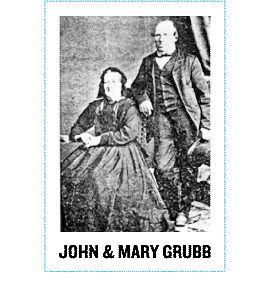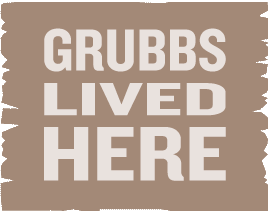In the beginning was …
Grubb Cottage.
Grubb Cottage is the original construction on the first piece of land to be sold in New Zealand by the Canterbury Association which had not been pre-purchased in England.
Mr John Grubb was one of the earliest residents of Lyttelton. he was born at Tayport, Fifeshire, Scotland in 1817. He trained as a shipwright and gained his mates certificate. He was a ships carpenter on the General Palmer when that vessel, on a journey from Melbourne to London in 1847, put into Wellington in a leaky condition, and was there condemned.
John Grubb came to Lyttelton in 1848, and in July 1849 began the construction of Lyttelton's first Harbour work, the construction of a 150x15 foot jetty. The work was done by Donald Gollan, John Grubb, James McNeil and the Allan brothers (Magnus and Robert Allan, from Port Levy); it was completed by the end of 1849 for the Canterbury Association.
His wife Mary and 3 children came out to New Zealand on the Charlotte Jane in 1850, and lived in a V hut that he had built for them. John had written to Mary beforehand and asked her to bring with her various carpentry tools: cross cut saws, an axe, an adze, steel chisels, files, planes, braces and bits. These were no doubt useful in building their first house in 1851 on the section that John had purchased.
He and the Allans built several punts and lighters for use around the port and to transport settlers' belongings around to Sumner and Heathcote. He also built the first Heathcote ferry punt for Thomas Hughes. With fellow Scottish emigrant George Marshall he also built a small vessel named "The Caledonia", which traded between Lyttelton and Wellington. At Pigeon Bay he built "The Canterbury", which also traded in Wellington. Settling in Lyttelton, Grubb started in business as a shipwright, and he owned the first ship in the port. The Torpedo Boat Museum at Magazine Bay, where Grubb later moved his business, commemorates his shipbuilding.
John Grubb was for many years a member of the early Borough Council. As a Freemason he was treasurer of Lodge Canterbury Kilwinning for about 20 years. In conjunction with the Deans of Riccarton, he was instrumental in establishing St Andrews Church in Christchurch, and for many years he was an elder of St Johns Presbyterian Church, Winchester Street, Lyttelton.
John Grubb's wife, Mary, died in Lyttelton in 1886; John Grubb died in 1898, and is buried in Lyttelton's Canterbury Street cemetery.
A Time to Celebrate.
As a result of a resolution passed on the 28th of May 2008, Christchurch City Council demonstrated its commitment to the retention and reservation of the heritage of Christchurch and Banks Peninsula. Council decided it would retain ownership and commit funding over the next two years to fund the conservation and stabilisation work of Grubb Cottage.
Grubb Cottage Heritage Trust was incorporated on the 20th of September 2007 and will provide the ongoing management of the Grubb Cottage site once the restoration work has been completed. The Trust will act as the link between the public and this historic asset and will serve to record and present the stories associated with the site.
Grubb Cottage is listed as a protected building under the Banks Peninsula District Plan and registered as a Category II Historic Place under the Historic Places Act. The Cottage remains in very original condition, including its original outbuildings. There are few examples of early settler dwellings still existing in Christchurch and Lyttelton, and no others are in such an original condition as the front section of Grubb Cottage.




